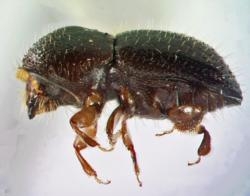
How to Attract an Ambrosia Beetle that Attacks Avocado and Sycamore
There's a lot of work being done in Florida on a pest/disease complex like we have here with Shot Hole Borer and Fusarium fungus – Fusarium Dieback. This hits avocados and a lot of other native trees like sycamore, willow and coast live oak. Some of the success in Florida may be applicable and we are working with their researchers there to adapt some of the techniques here.
Redbay ambrosia beetle, Xyleborus glabratus, is a wood-boring pest that has now invaded nine states in the southeastern United States. The beetle's dominant fungal symbiont (Raffaelea lauricola) is phytopathogenic, inducing laurel wilt in trees within the family Lauraceae. Members of the genus Persea are particularly susceptible to the lethal disease, including native redbay (P. borbonia) and swampbay (P. palustris), as well as commercial avocado. Cubeb oil lures are the current standard for detection of X. glabratus, but recently eucalyptol and a 50% α-copaene oil have been identified as additional attractants. This study used a combination of choice bioassays, field cage release-and-recapture assays, and a 12-week field trial to compare efficacy of eucalyptol and copaene lures relative to commercial cubeb lures. In addition, gas chromatography (analyzer for volatiles) was used to quantify emissions from lures field-aged for 12 wk. In field cage assays, copaene lures recaptured a higher percentage of released beetles than cubeb lures. In the field test, cubeb lures captured fewer beetles than copaene lures, and lowest captures were obtained with eucalyptol lures. Both copaene and cubeb lures were effective in attracting X. glabratus for 12 weeks, but field life of eucalyptol lures was only 4 weeks, consistent with the quantification of lure emissions. Results suggest that the 50% α-copaene lure provides the best pest detection currently available for X. glabratus.
So why is this important? For one, it will serve as a tool for more effectively monitoring the presents of the beetle. But more importantly, it might be used as a lure to attract them away from trees. Fool them into going somewhere else, like to die.

shot hole borer
